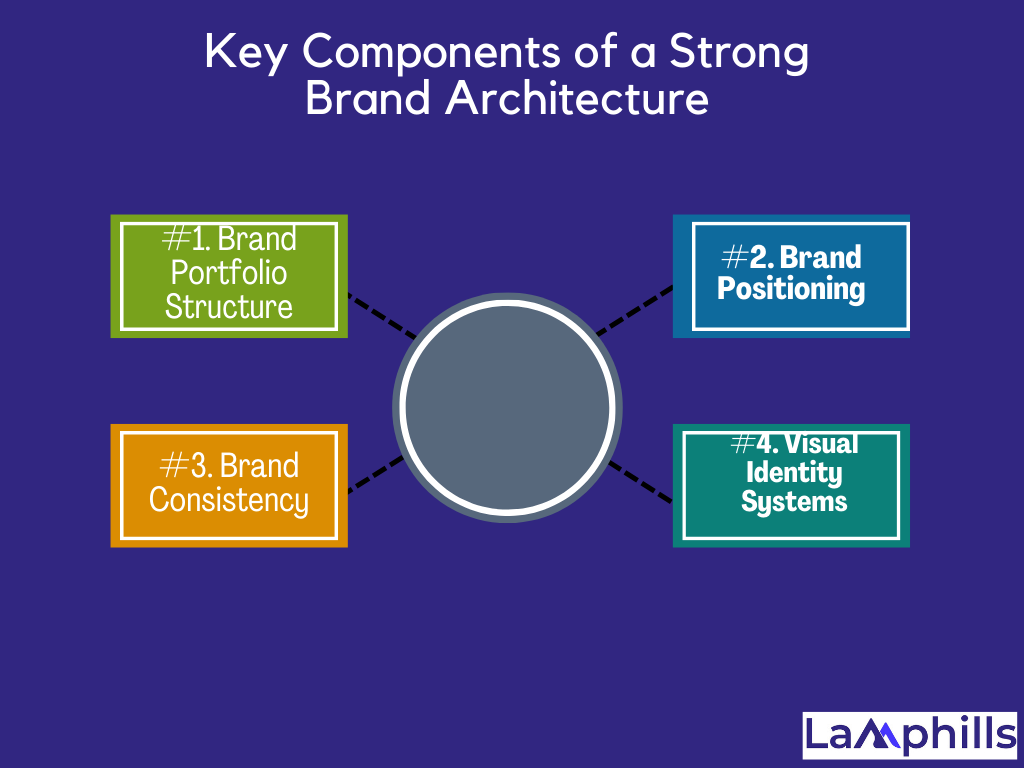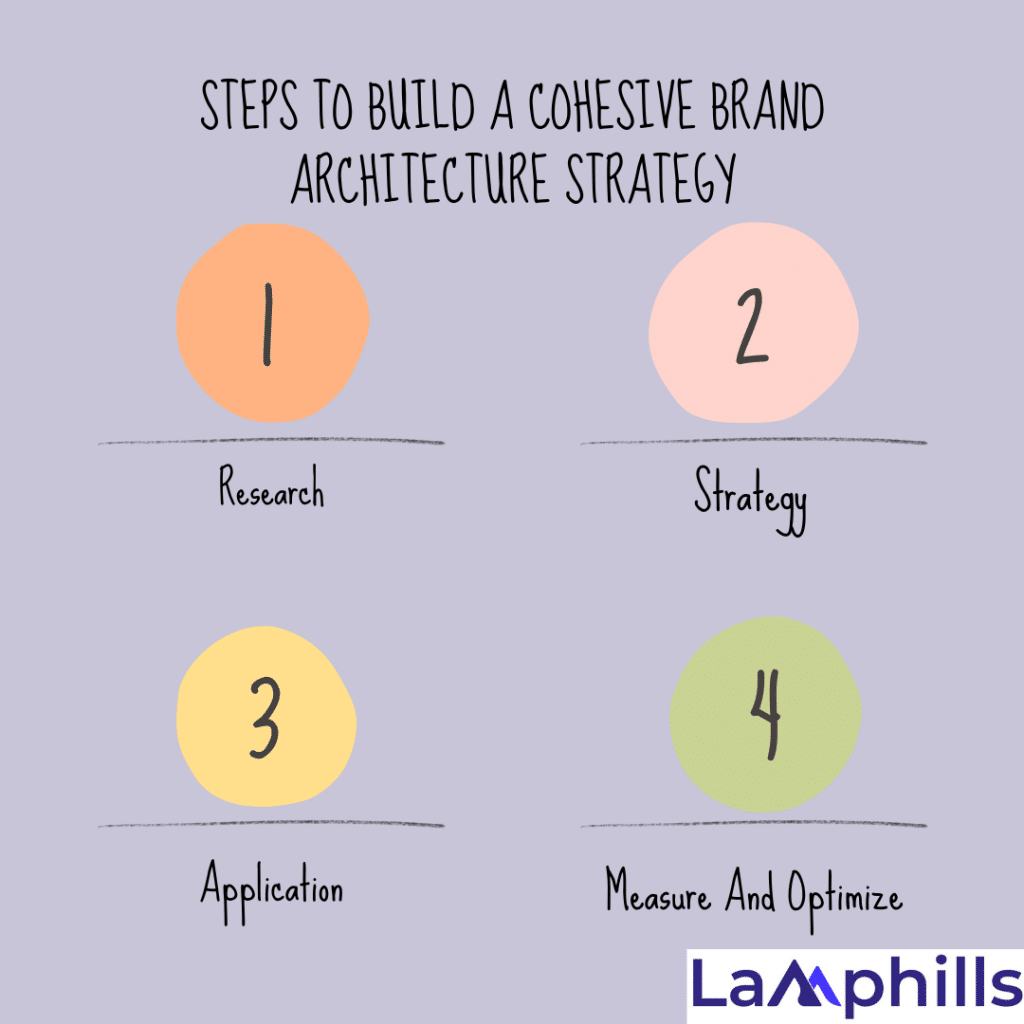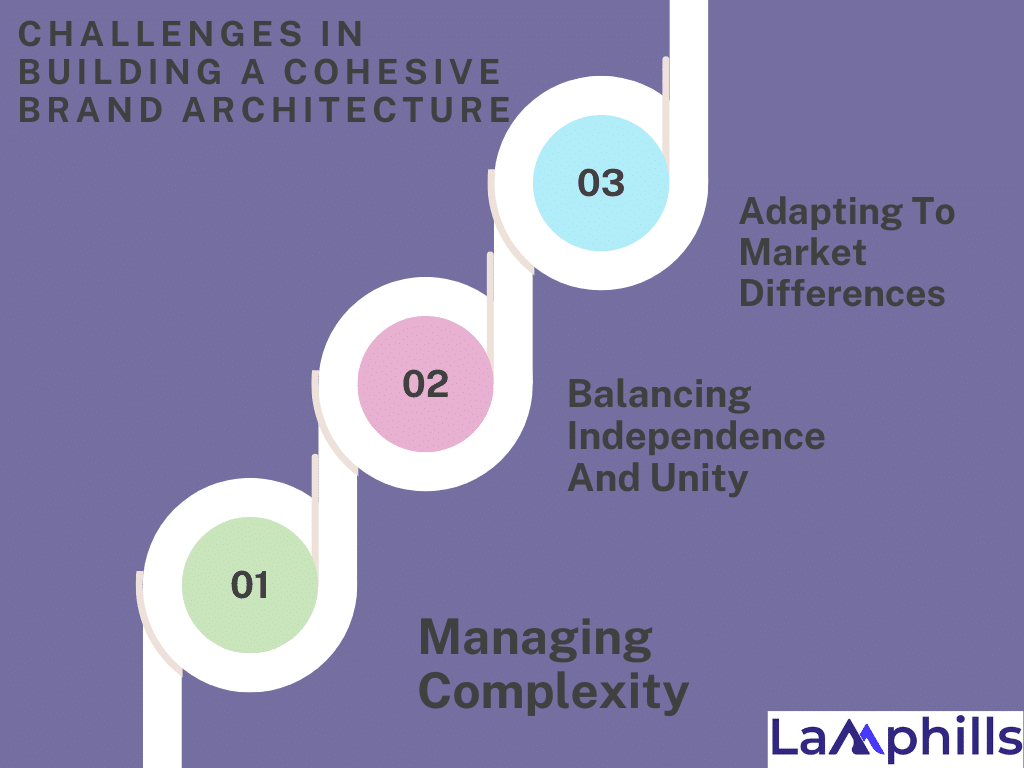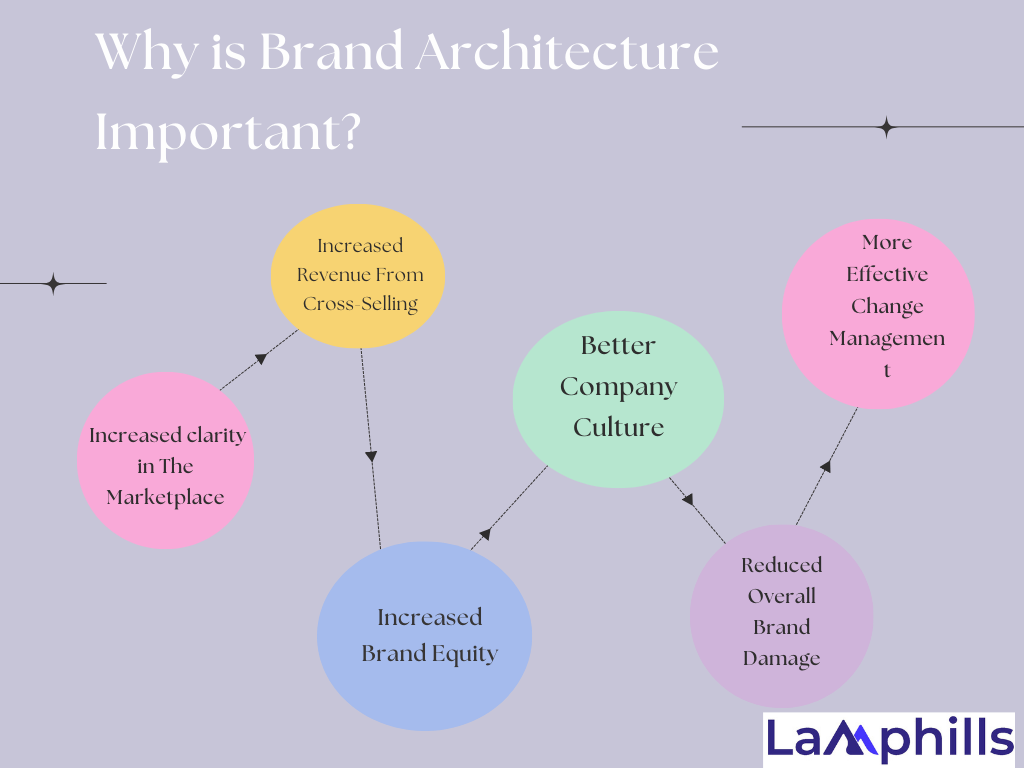Just hearing the term “brand architecture” gives up images of blueprints, structures, and sophisticated designs. However, instead of concrete and steel, your brand portfolio requires careful planning and management. And, just like building a physical structure, developing a great brand architecture provides the groundwork for long-term commercial success.
Whether you’re managing a single product line or a vast empire of sub-brands, mastering brand architecture is critical to assuring your company’s success in today’s competitive market. In this article, I’ll explain what brand architecture is, why it matters, and how to develop a unified strategy that will position you for multi-brand success.
Key Takeaways
- A well-executed brand architecture enhances clarity in the marketplace, helping consumers understand your product offerings and the relationships between your brands. It also serves as an internal roadmap, guiding employees on how to position and communicate the brand effectively
- Companies can choose from various brand architecture models—branded house, house of brands, endorsed brand, or hybrid—depending on their strategic goals and market needs. Each model comes with its advantages, from leveraging the master brand’s equity to allowing sub-brands to have independent identities.
- Consistent visual elements such as logos, colors, and design should be aligned across brands to build trust and brand recognition, even if the sub-brands have distinct personalities. This consistency reinforces the parent brand’s overall message.
- By organizing your brands strategically, you can contain brand damage and cross-leverage brand equity. A clear structure also facilitates growth through cross-selling opportunities and enhances change management, allowing businesses to adapt to market shifts effectively.
What Is Brand Architecture?

Every business, like any structure, requires brand architecture. It is the framework that enables you to arrange your offerings, establish a brand identity, and build brand equity. The correct brand architecture defines your products or services and determines how your brands and sub-brands interact with one another.
Without this structure, there is no link between your brand’s offerings, messaging, and identity. This discrepancy can lead to consumer confusion and reduce the brand’s overall value. (Imagine strolling through a building with dramatically varied interior designs. Brand architecture outlines each brand’s position and serves as a guideline for how your organization’s brands interact with one another.
When thinking about adding a new brand or product, it is crucial to understand where it will sit within your organization. In other words, you will have to define what type of brand architecture you will choose for your portfolio of brands. To simplify the concept, imagine that your organization is a house:
- Where will your brand be located within the architecture of that house?
- Which role will each brand play?
- What will be its relationship with other brands, if any?
The answers to these questions will guide you in choosing the adequate brand architecture framework for your organization.
Understanding Brand Architecture
Brand architecture is a framework for organizing brands, products, and services so that people can find, understand, and react to them. This helps to structure a brand portfolio, allowing customers to immediately recognize which brands are related and at what level. It enables your customers to grasp the breadth and depth of your products or services. An established brand architecture is useful when creating brand expansions, sub-brands, and new goods.
Brand architecture provides a framework for developing and designing brand identities. Furthermore, it reminds customers of the overall brand family’s value proposition. As a result, it maximizes brand value by using both your main brand and sub-brands.
Companies utilize brand architecture to guide their internal activities. It serves as the foundation for the brand identity, style guide, and brand story, while also increasing efficiency by emphasizing opportunities for cross-promotion, brand awareness, and mergers and acquisitions.
Consumers don’t always recognize brand architecture, which they use to categorize companies and understand how they meet their demands. For example, many people may be unaware that Alphabet is Google’s parent firm. However, they have a specific sense of Google’s brand equity and apply it to products such as Google Sheets, Google Docs, and Google Search.
Ultimately, brand architecture is meant to bring order to a brand’s offerings and build brand equity. Not every architecture will work for every business, so let’s look at the options to see which may be the right fit for your brand.
Key Components of a Strong Brand Architecture

When you’re building a house, you don’t just start hammering nails into wood without a plan. Similarly, you need to develop a solid strategy when building your brand architecture. Here are the most important elements:
#1. Brand Portfolio Structure
This is where you map out all of the brands you presently have and those you plan to add in the future. Are certain brands dominating, while others play supporting roles? Defining the duties of each brand in the portfolio allows you to eliminate overlap and repetition.
When working with a retail customer, we discovered that their portfolio contained too many brands selling comparable products at slightly varying prices. This reduced their sales and created unnecessary confusion. We streamlined their offers, consolidated a few companies, and built a more organized structure. Sales increased almost quickly as clients had a clearer choice.
#2. Brand Positioning
Once you’ve gone through your portfolio, the next step is to position each brand with a clear value proposition. To avoid brand overlap, each brand must target a specific demographic and maintain a distinct personality. You don’t want your brands competing with each other.
#3. Brand Consistency
Maintaining a consistent brand language and tone across all of your brands is critical. However, consistency does not imply uniformity. Each brand can and should have a distinct personality, but the basic principles and message must be consistent.
#4. Visual Identity Systems
This is where design comes in. Your logos, color schemes, fonts, and even taglines must have a consistent appearance and feel throughout your companies. When a brand’s visual identity is disconnected, it can undermine customer trust.
Brand Architecture Models and Frameworks
When I was working with a client in the hospitality business, they were faced with a similar dilemma: should they use one master brand for all of their hotel locations or allow each one to stand on its own? After much consideration (and some trial and error), we decided on an approved brand strategy that would allow their sub-brands to shine while still relying on the parent brand’s legitimacy. It was a balancing act, but it paid dividends in terms of customer trust and brand recognition. The most popular brand architecture models are branded houses, residences brands, endorsed brands, and hybrid brands.
#1. Branded House
A branded house architecture combines several house brands under a single umbrella brand, leveraging the well-established master brand for its equity, awareness, and customer loyalty. Oftentimes, the house brands are designed to target different audience segments to maximize reach and revenue.
For instance, Apple uses a branded house architecture to create a seamless look and feel across its sub-brands: iPad, iPhone, iMac, Watch, and TV. By leaning on Apple’s loyal customer base, the sub-brands increase their equity and more easily attract buyers.
The following companies use a branded house architecture:
- FedEx: FedEx Express, FedEx Ground, FedEx Freight, FedEx Office, etc
- Virgin: Virgin Mobile, Virgin Pulse, Virgin Money, etc
- HubSpot: Marketing Hub, Sales Hub, Service Hub, Content Hub, Operations Hub
#2. House of Brands
A house of brands architecture focuses on the sub-brands rather than the master brand. This structure allows sub-brands to shine on their own because they are not bound by the master brands’ messaging, appearance, or placement. However, it also adds complexity because each company has a unique audience, brand identity, marketing plan, and equity.
Because of the intricacy, firms that adopt a house of brand structure are often major worldwide brands with existing equity. While the master brand may be well-known, such as the consumer goods giant Unilever, it can also be hidden, as with the fast-food company Yum! Brands.
The following companies use a house of brands architecture:
- Procter & Gamble: Pampers, Tide, Bounty, Bounce, Dawn, Tampax, and more
- Yum! Brands: KFC, Pizza Hut, Taco Bell, and The Habit Burger Grill
- GE Appliances: Monogram, Café, GE, GE Profile, Haier and Hotpoint
- Focus Brands: Aunties Anne’s, Cinnabon, Jamba Juice, Carvel, and more
- PepsiCo: Pepsi, Lays, Quaker Oats, Gatorade, Aquafina, Tropicana, and more
#3. Hybrid Brand
A hybrid brand architecture blends the house of brands and branded housing designs. The purpose of this structure is for the sub-brands to have comparable styles to the master brand while preserving their own brand identities.
Companies that utilize a hybrid architecture may mention the master brand in marketing, but the majority employ this strategy to keep the master and sub-brands separate following rounds of mergers and acquisitions. It’s also an excellent strategy for brands who wish to reach a wide range of target consumers, such as Marriott Bonvoy. Using a hybrid strategy, the corporation maintains a diversified portfolio of brands that includes luxury hotels, such as the Ritz-Carlton, alongside budget-friendly options, such as Residence Inn.
The following companies use a hybrid approach:
- Alphabet: Google, Nest, YouTube, Fitbit, Waze, and more
- Microsoft: LinkedIn, Skype, GitHub, Mojang, and more
- Amazon: AmazonBasics, Presto!, Mama Bear, AmazonFresh, Zappos, and more
- Levi’s: Levi’s, Dockers, Denizen, and Signature by Levi Strauss & Co
#4. Endorsed Brand
Another option for brand architecture is the approved brand model, which consists of a master brand and sub-brands that are associated with it. Each sub-brand benefits from the strength of the others because they all receive the same endorsement.
Often, an approved brand uses the master brand’s logo and colors. Of course, this allows the sub-brand to benefit from the primary brand’s reputation, resulting in increased brand equity, awareness, and security.
The approved strategy is ideal for firms who take a hybrid approach and want each sub-brand to have its own identity without being separated from the master brand. Unlike the house of brands strategy, the approved model informs everyone about the main brand. behind the products or services. And unlike the branded house approach, an endorsed brand can have a different look or feel from the master brand.
The following brands use an endorsed approach:
- Nescafe by Nestle
- Playstation by Sony
- Rice Krispies by Kellog
- Polo by Ralph Lauren
Steps to Build a Cohesive Brand Architecture Strategy

Now that you know the core components and types, here’s a step-by-step guide to creating a cohesive brand architecture strategy.
#1. Research
Strong brands don’t simply choose a model and run with it. Therefore. conducting research is an essential step in developing brand architecture because it gives you the information you need to organize offerings in a way that makes sense for your company, customers, and industry.
The more data, the better. But gathering the following information will provide the insights you need to get started.
- Brand audit: brand loyalty, brand awareness, brand perception, brand equity, brand assets, and brand portfolio
- Market research: buyer personas, market segmentation, product/service use, pricing, customer satisfaction, and competitive analysis
Before you make any decision, it’s wise to review your company’s mission, vision, and values to ensure the brand architecture aligns with business goals.
#2. Strategy
With data in hand, it’s time to design the brand architecture. If you’re revamping an old architecture, this step may require tough decisions on whether to get rid of or sell brands that don’t fit into your desired architecture. If you’re starting from scratch, you have to decide how closely you want your current (or future) sub-brands to be connected to the master brand.
You can test out each architecture by seeing what the brand would look like in each approach and creating a list of pros and cons. Maybe the branded house model won’t work because you have several distinct brands that can’t be grouped under the parent brand.
When you find a structure that may work, outline the connections between the master brands, sub-brands, and products or services. You need to know how everything works together by defining distinct brands, designing cross-promotions, or marketing to customers.
Also, documenting your brand architecture plan is vital. Create standards for how each brand should communicate, its visual identity, and its place in the larger portfolio. These principles serve as a framework for future decisions.
Remember to take into account your available resources (workers, budget, and time). Certain approaches need more work than others, so choose a brand architecture that is appropriate for both your current capacity and your future goal.
#3. Application
Choosing a brand architecture is only the first step toward building a long-lasting brand that people love. But, for the sake of this article, this step is to discuss the finalized structure with your team.
Because brand architecture is a component of your brand identity, you can reveal it with your overall brand positioning plan. Include a clear structure that demonstrates the interconnections between the master brand, subbrands, and offerings, as well as any ties between subbrands. Everyone on the team should understand each brand’s strategic position inside the architecture framework and its relationship to customers.
As your company grows, your brand architecture must alter to embrace any new offerings or brands, whether they are the consequence of a new product launch or an acquisition.
By investing time in brand research, developing a brand architectural strategy, and sharing it with your team, you are preparing your entire company to make effective branding decisions that will have a long-term impact on brand equity.
#4. Measure And Optimize
Brand architecture is not a “set it and forget it” approach. Monitor the performance of your brands using KPIs such as brand equity, consumer perception, and financial performance. Prepare to change your strategy as your firm grows.
Challenges in Building a Cohesive Brand Architecture

Of course, like any business strategy, building a strong brand architecture comes with its challenges. Here are a few common ones and how to overcome them:
#1. Managing Complexity
If you have too many brands in your portfolio, things can become confusing quickly. Ensure that each brand serves a clear function and does not cause confusion. If your portfolio begins to feel cumbersome, it may be time to streamline.
#2: Balancing Independence And Unity
While each brand should have its own personality, it must remain true to the company’s basic principles. Balancing independence and cohesion can be difficult, but it’s critical for sustaining a consistent brand narrative.
#3: Adapting To Market Differences
What works in one market may not work in another. Adapting your brand architecture to multiple cultural or geographical contexts while being consistent is critical to global brand success.
Why is Brand Architecture Important?

Brand architecture becomes increasingly important when firms increase their products. I remember one of my earlier consulting contracts, in which a rapidly rising technology business was expanding outside its primary product. They had multiple sub-brands, each offering unique services, but no clear plan for organizing them. The end consequence was confusion for both their customers and internal personnel.
A well-thought-out brand architecture gives clarity and structure in these instances, allowing both your customers and workers to grasp the relationships between your brands. Finally, let’s discuss why all of this matters. A well-executed brand architecture can result in several concrete benefits for your business:
#1. Increased clarity in The Marketplace
Building a brand architecture enables people to understand your company and brands in the way you want them to. It will make product alternatives clear for all stakeholders, including customers and employees.
#2. Increased Revenue From Cross-Selling
A well-defined framework allows businesses to feed off one another by offering enticing products and value propositions tailored to a variety of audiences. If a company can give a positive experience with one brand, it generates numerous opportunities for its associated partners inside the brand portfolio.
#3. Increased Brand Equity
Brand equity refers to the worth of a brand. It is the difference in value between a branded product and the same item without the brand name attached.
All brands offering a specialized niche will ultimately drive growth and positively promote the parent company. The parent company has consequently more ability to generate new revenue, expand its customer base, and increase the entire organization’s value (= brand equity).
#4. Better Company Culture
Employees understand their brand’s place in the bigger picture and feel more included. Brand architecture hence creates a sense of belonging.
#5. Reduced Overall Brand Damage
Threats to the image of a brand do not necessarily have a direct, negative impact on the brand image of the parent company. Depending on the chosen brand architecture model, the damage can be contained and not spread across the entire organization.
#6. More Effective Change Management
Responding to external influences, all brands must adapt and change over time. A clear system can aid in managing the process, ensuring that necessary changes are implemented effectively and efficiently.
What are brand pillars?
Brand pillars are a series of characteristics and values that define your company’s identity and personality.
What is a brand architecture matrix?
Brand architecture is an arrangement of brands within an organization or company.
What is the difference between brand hierarchy and brand architecture?
Brand architecture refers to the overall structure of a company’s brands and how those brands relate to one another. Brand hierarchy, on the other hand refers to the arrangement of brands and products within the overall brand architecture.
Conclusion
Mastering brand architecture is not just about organizing your brands—it’s about creating a roadmap for future growth. By developing a clear, cohesive brand strategy, you can ensure your business is set up for long-term success, no matter how complex your portfolio becomes. Take the time to assess your current structure, define roles, and streamline where necessary. Your future self—and your customers—will thank you.






